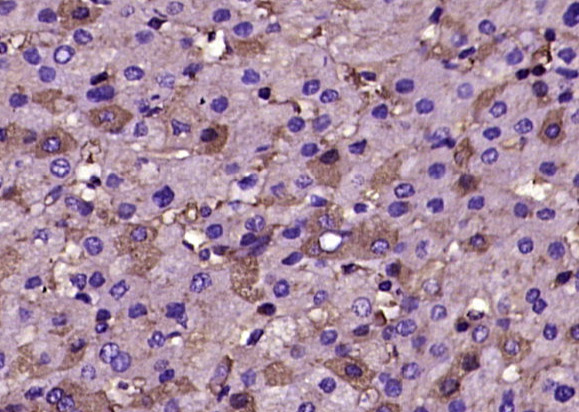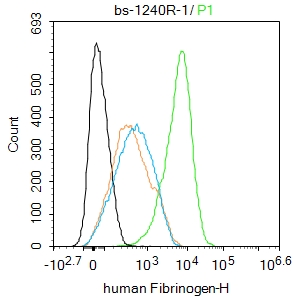
Details
Product Name human Fibrinogen Chinese Name 人纤维蛋白原抗体 Alias FGA; FGA protein; FGB; FGG; Fib2; Fibrin alpha chain ;Fibrinogen A alpha polypeptide; Fibrinogen A alpha polypeptide chain; Fibrinogen alpha chain; Fibrinogen B alpha polypeptide; Fibrinogen beta chain; Fibrinogen G alpha polypeptide; Fibrinogen gamma chain; MGC104327; MGC119422; MGC119423; MGC119425; MGC120405; FIBA_HUMAN. literatures Research Area Cell biology immunology Signal transduction Cytoskeleton Immunogen Species Rabbit Clonality Polyclonal React Species Human, Rat, (predicted: Mouse, ) Applications ELISA=1:5000-10000 IHC-P=1:100-500 IHC-F=1:100-500 Flow-Cyt=1μg /test IF=1:100-500 (Paraffin sections need antigen repair)
not yet tested in other applications.
optimal dilutions/concentrations should be determined by the end user.Theoretical molecular weight 95/340kDa Cellular localization Secretory protein Form Liquid Concentration 1mg/ml immunogen Fibrinogen from human plasma Lsotype IgG Purification affinity purified by Protein A Buffer Solution 0.01M TBS(pH7.4) with 1% BSA, 0.03% Proclin300 and 50% Glycerol. Storage Shipped at 4℃. Store at -20 °C for one year. Avoid repeated freeze/thaw cycles. Attention This product as supplied is intended for research use only, not for use in human, therapeutic or diagnostic applications. PubMed PubMed Product Detail Fibrinogen is the main protein of blood coagulation system. It is a large protein and it consists of two identical subunits that contain three polypeptide chains: alpha, beta and gamma. All chains are connected with each other by a number of disulfide bonds. Fibrinopeptides A (1 to 16 amino acids) and B (1 to 17 amino acids) are released by thrombin from the N terminal parts of alpha and beta chains, respectively. In this way fibrinogen is converted into fibrin, which by means of polymerization forms a fibrin clot. Fibrinogen clotting underlies pathogenesis of MI, thromboembolism and thromboses of arteries and veins, since fibrin is the main substrate for thrombus formation. Fibrinogen activation is also involved in pathogenesis of inflammation, tumor growth and many other diseases. The normal fibrinogen concentration in plasma is about 3 mg/ml. The elevated level of fibrinogen in patient's blood is regarded as an independent risk factor for cardiovascular diseases. An increase in blood fibrinogen concentration was shown to be a strong predictor of coronary heart disease (Sonel A. et al, and Rapold H.J. et al). All these facts make fibrinogen an important parameter in the diagnosis of cardiovascular diseases.
Function:
Fibrinogen has a double function: yielding monomers that polymerize into fibrin and acting as a cofactor in platelet aggregation.
Subcellular Location:
Secreted.
Tissue Specificity:
Plasma.
Post-translational modifications:
The alpha chain is not glycosylated.
Forms F13A-mediated cross-links between a glutamine and the epsilon-amino group of a lysine residue, forming fibronectin-fibrinogen heteropolymers. About one-third of the alpha chains in the molecules in blood were found to be phosphorylated.
Conversion of fibrinogen to fibrin is triggered by thrombin, which cleaves fibrinopeptides A and B from alpha and beta chains, and thus exposes the N-terminal polymerization sites responsible for the formation of the soft clot. The soft clot is converted into the hard clot by factor XIIIA which catalyzes the epsilon-(gamma-glutamyl)lysine cross-linking between gamma chains (stronger) and between alpha chains (weaker) of different monomers. Phosphorylation sites are present in the extracellular medium.
Similarity:
Contains 1 fibrinogen C-terminal domain.
SWISS:
P02671
Gene ID:
2243; 2244; 2266;
Database links:Entrez Gene: 2243 Human
Entrez Gene: 2244 Human
Entrez Gene: 2266 Human
Entrez Gene: 110135 Mouse
Entrez Gene: 14161 Mouse
Entrez Gene: 99571 Mouse
Omim: 134820 Human
Omim: 134830 Human
Omim: 134850 Human
SwissProt: P02671 Human
SwissProt: P02675 Human
SwissProt: P02679 Human
SwissProt: Q8K0E8 Mouse
SwissProt: Q8VCM7 Mouse
Unigene: 300774 Human
Unigene: 351593 Human
Unigene: 727584 Human
Unigene: 16422 Mouse
Unigene: 30063 Mouse
Unigene: 88793 Mouse
Product Picture
Primary Antibody (green line): Rabbit Anti-human Fibrinogen antibody (SL1240R)
Dilution:1ug/Test;
Secondary Antibody(white blue line): Goat anti-rabbit IgG-AF488
Dilution: 0.5ug/Test.
Isotype control(orange line): Normal Rabbit IgG
Protocol
The cells were fixed with 4% PFA (10min at room temperature)and then permeabilized with 90% ice-cold methanol for 20 min at -20℃, The cells were then incubated in 5%BSA to block non-specific protein-protein interactions for 30 min at room temperature .Cells stained with Primary Antibody for 30 min at room temperature. The secondary antibody used for 40 min at room temperature. Acquisition of 20,000 events was performed.
Bought notes(bought amounts latest0)
User Comment(Total0User Comment Num)
- No comment




 +86 571 56623320
+86 571 56623320
 +86 18668110335
+86 18668110335

